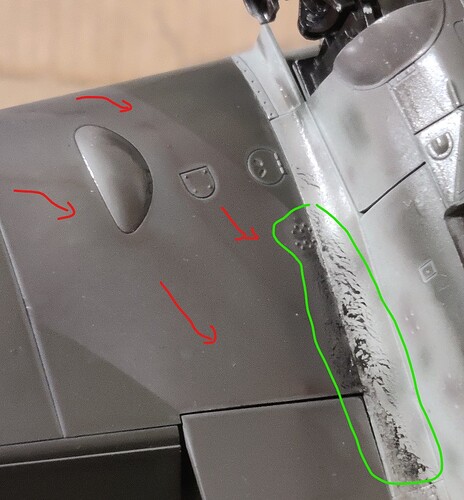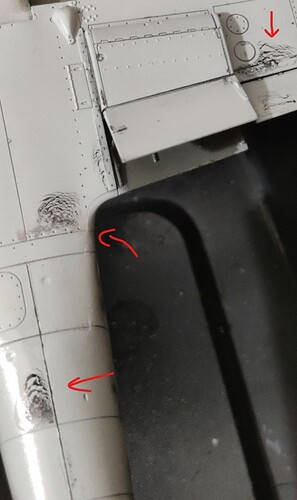[TL:DR: I messed up badly my gloss coat before the decals ; based on the included pictures, how could I fix this mess ?]
Hey people!
So, I think I’m getting pretty decent at building, priming, and painting my kits, but if there are steps that really terrify me, well, it’s the clear coats. Extra points when it’s matte.
And lo and behold, I indeed messed up my model BAD, sigh… With the gloss. Congrats to me.
What happened, actually, is that while I was wet coating over my initial mist coats, a sudden, big sputter from the airbrush send droplets flying all over the model, immediately followed by the release of a heavy flow of Tamiya x22+Mr Hobby Leveling Thinner, resulting in durable spots on the wing as well as a very visible trace of fluid that damaged the paint on the wing root. Additionally, and probably the cause of the sputter, the coat had become a bit contaminated and tinted in red !
As a result of all this, the left wing became very tacky, despite an attempt to smooth it by spraying pure MLT. It did help get rid of some pooling and removed a few red spots, but I could never get my left wing glossy coat to look smooth or remove the very visible droplet marks.
Also, due to the surprise, I didn’t notice immediately that some big drops of what I think was almost pure MLT had been sprayed all the way to the right wing tip, really burning the paint and probably the plastic, as it looks like crazing here ( miraculously, the flanks were spared ).
Finally, the underbelly got damaged too, mostly because in my panic I may have put it down on the base I use, maybe to grab something to suck the flood, disturbing the already done but not yet dry coat.
Well, I thought I had good airbrush cleaning ethics and techniques : apparently, I don’t.
I will need to remember to regularly spray using high pressure to help get rid of any clogs in the unreachable channel…
So my question : is there a way to fix this mess ?
Am I doomed to strip the paint ? Should I sand and repaint and recoat, which I suspect may take quite some time and sounds hazardous ? Is there a trick someone knows and would be willing to share ?
Or should I just shrug, sh!t happens, go on ?
I must say I was super happy with the way things were going, and this was kinda demoralizing. I was fortunate, at least, to get this on the coat before the decals, not after !
Thanks for any advice or help with this matter !
Additionnal info:
- Using a CREOS gsi Procon boy PS289, with air control and a 0.3needle
- Primer was Mr Color Surface Finisher 1500, black, thinned with Tamiya Lacquer Thinner ; paints were various Tamiya Acrylics, thinned first with Tamiya x20a, then MLT when I got my batch.
- Tamiya x22 thinned loosely 2:1 with Mr Leveling Thinner
- Two tack coat, 15psi ( 20 on the compressor, air control on the airbrush tuned down to lower pressure ). Medium paint flow. 10-12 cm distance.
- Wet coat 1, 20psi, slightly higher paint flow, 8-10cm.
- Sputter, panic.
- Second wet coat, hoping it would get rid of the tacky coat on the wing, droplet marks, red marks, and pooling that occured after the accident. It mostly worked.
- A lighter wet coat of pure MLT to smooth out the last coat. Worked well where it worked.
- Has been drying for 24h, it’s very hot here these days.



